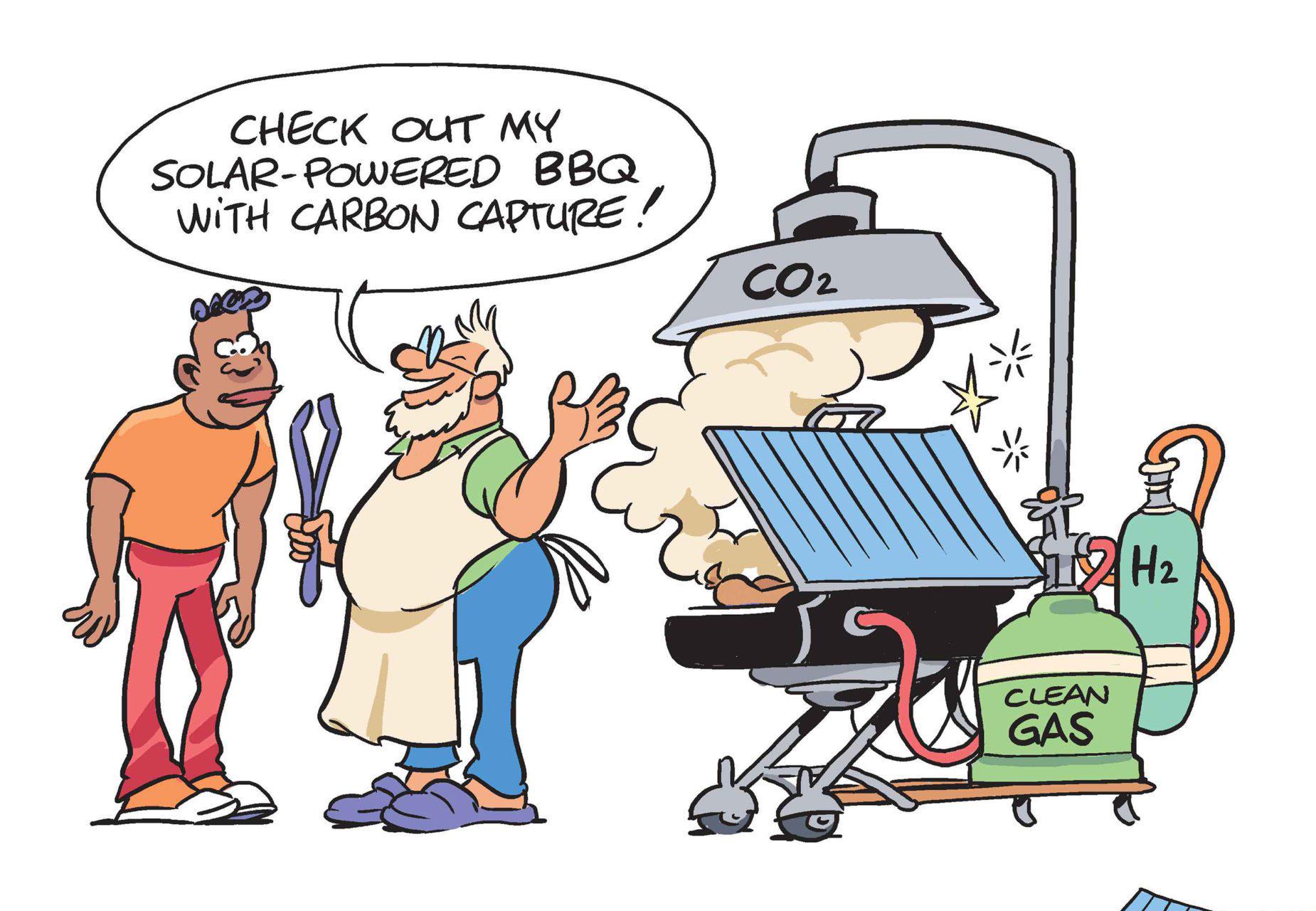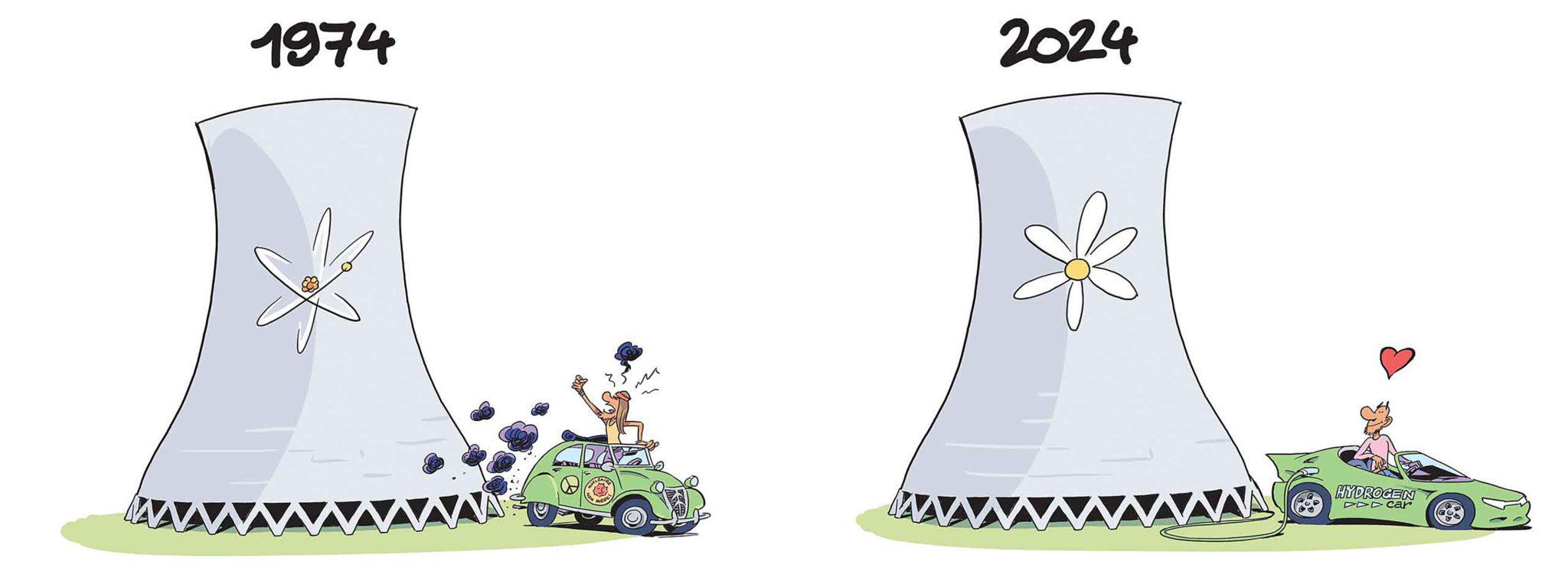
Illustration © Éric Buche
Green hydrogen could transform our energy system and solve many supply and emissions challenges. Whether this happens will depend on how economically it can be produced and attractive it will be to consumers.
Among the promising technologies for powering a net-zero future, hydrogen is a bit of an outlier. While solar panels, wind turbines, and hydropower plants all harness energy provided by nature and transform it into electricity, hydrogen doesn't fit into that mold. Andreas Züttel, head of EPFL's Laboratory of Materials for Renewable Energy, explains why: "Hydrogen is not an energy source, it's an energy carrier."
Already today, hydrogen is at the core of our energy system. Packing more energy per unit mass than any other substance known to man, hydrogen serves as the primary energy carrier in our fossil fuels. Hydrogen's free combustion with oxygen has blasted rockets into space. And thanks to our ability to control its combustion in fuel cells, it now powers a steadily growing fleet of vehicles on our roads.
According to Züttel, the problem with the hydrogen used today is that most of it, some 95%, is dirty. Where we rely on it, as in hydrocracking in oil refineries, producing synthetic fertilizers, and in the chemical industry, we source it from fossil fuels - which means a hefty carbon footprint.
A challenging shift to green and clean
Surprisingly, this very same substance is being hailed as a vital contributor to a net-zero-emissions energy system. The Swiss Federal Office of Energy (SFOE) sees clean, green hydrogen playing an important role in Switzerland's clean energy mix by 2050, starting from close to zero today.
Achieving this will require a major hydrogen clean-up. To shift from dirty hydrogen to clean hydrogen will require addressing hydrogen's many inherent challenges. Chemically, its lack of a liquid phase at room temperature makes it difficult to store. It is notoriously explosive, making it delicate to handle. And its inability to be odorized complicates leak detection.
In terms of energy efficiency, hydrogen lags behind other energy sources, requiring vast amounts of energy - 66 kilowatt hours per kilogram - to be produced. And the same is true from an economic perspective, with the cost per kWh of energy carried by hydrogen around two to three times higher than the market price for electricity.
Given all these drawbacks, why is there so much hope for hydrogen? Because, under the right conditions, this renewable energy carrier's properties could address challenges that will arise as we move towards a cleaner and greener energy mix.

The Swiss Army Knife of energy carriers
Research into hydrogen as an energy carrier surged in the 1990s, says Züttel. "When I entered the field 32 years ago, we thought hydrogen would replace all fossil fuels. In those days, we weren't yet hoping to combat global warming, we were trying to address the fear that fossil fuels would soon run out." As new fossil fuel deposits were discovered and increased production drove down their cost, the hydrogen hype cooled down.
But now, the pendulum has swung right back. Hydrogen is once again in the spotlight, says Züttel. This time it's for its potential to help curb global CO₂ emissions. While burning carbon produces heat-trapping CO₂, burning hydrogen produces nothing but water. If renewable electricity is used to produce hydrogen, for example through the electrolysis of water, the resulting hydrogen becomes an effective way to store renewable energy.
"Hydrogen is the key element on the path from renewable electricity to chemical energy carriers such as methane, methanol, synthetic oil or ammonia," explains Züttel. "While these can be produced using carbon from captured atmospheric CO₂ or from biomass, the hydrogen carries the renewable energy."
This makes hydrogen a valuable energy carrier for a variety of applications. Pure hydrogen can be used to generate electricity to meet peaks in demand, and it can power cars, busses, and heavy vehicles. If we managed to solve the storage, distribution and handling puzzle, then we could start using it as a carbon-neutral fuel for shipping and aviation.
Combined with carbon extracted from the atmosphere, biomass or industrial emissions, it could be further transformed into methane, synthetic oil, ammonia, methanol or other net-zero-emissions fuels. This would, again, come at the cost of overall energy efficiency. But in a world awash with renewable electricity, the increased volumetric energy density and safety of handling that these synthetic fuels provide help cut the carbon footprint of applications that are difficult to electrify.
Accelerating market adoption
Fortunately, says Züttel, there have been several breakthroughs on the path to market adoption of green hydrogen in transportation and electricity production, the two sectors responsible for more than half of the world's greenhouse gas emissions. They begin upstream of hydrogen production, where renewable electricity has already achieved price parity with standard electricity, decades earlier than initially predicted by the International Energy Agency, bringing down the cost of clean hydrogen with it.
Market forces have been a key driver in road vehicle applications, accelerating the development of fuel cells and safe high-pressure hydrogen storage cylinders. Despite these advances in technology, adoption of hydrogen-powered vehicles has been frustratingly slow. In fact, the main obstacle has been the lack of roadside infrastructure. Switzerland currently has eight hydrogen refueling stations, says Züttel. "People won't buy a hydrogen car if they can't fuel it. And who wants to run a fueling station if no one wants to buy the hydrogen? That's the reason why Toyota is not selling their fuel cell electric vehicles here."
As the share of intermittent renewable electricity carried by the power grid increases, power plants will likely become increasingly reliant on stored hydrogen to match the supply and demand for power. "If you have a lot of volatile electricity, say from solar or wind power, you can produce hydrogen and store it underground, for example. Then, you can use that in the wintertime to produce electricity with a high efficiency in combined cycle power plants that have a hydrogen fired turbine and a steam turbine," he says.
"For this to work, the whole market - and our expectations - will have to adapt. We are used to buying electricity at an almost constant price. To make storage attractive, the price of electricity during the night would have to be more expensive than during the day. And in the winter, we would have to be prepared to pay more than in summer months. But the more attractive it becomes to store electricity using hydrogen, the more such storages will be installed," he says.

To stimulate market growth on both the supply and the demand side, the industry has come up with a colorful solution - at least in name. Hydrogen is now being marketed on a color spectrum ranging from black to green based on carbon footprint. When developing new applications, hydrogen users can now make a conscious choice whether to prioritize carbon footprint or cost. This strategy will eventually nudge consumers up the spectrum towards greener hydrogen as it becomes more and more affordable.
However, as Züttel emphasizes, this only makes sense as a temporary strategy, in place long enough to build up demand for hydrogen and the infrastructure to distribute it. "Once we start using a lot of hydrogen, it will have to be renewable hydrogen only. Anything else would not really make sense."






